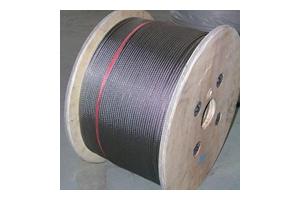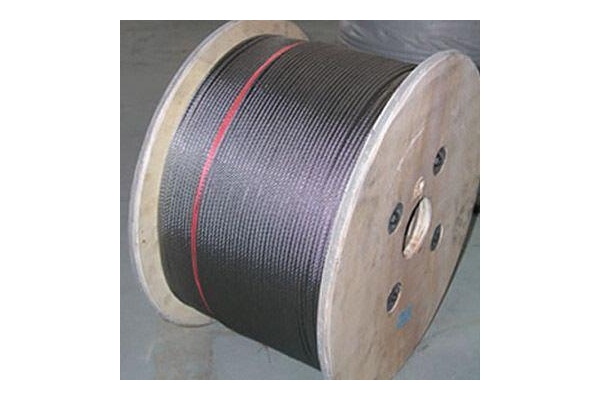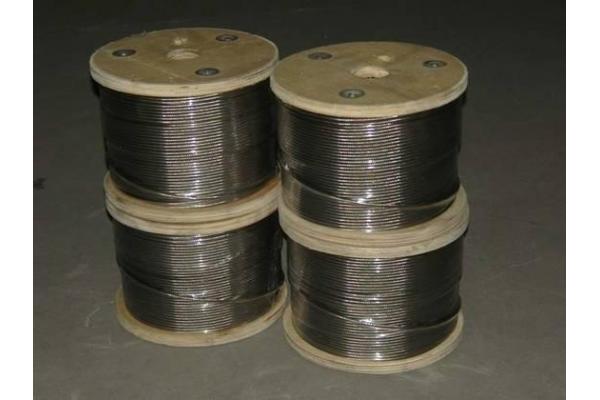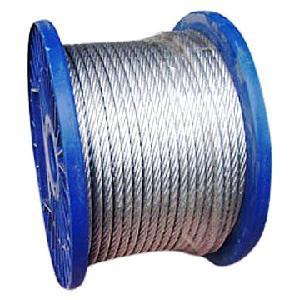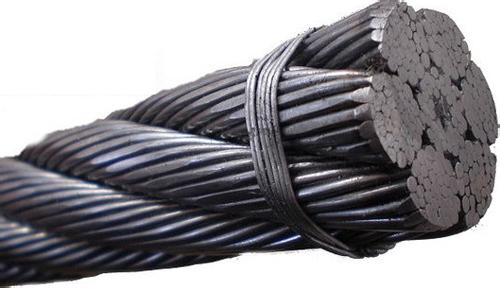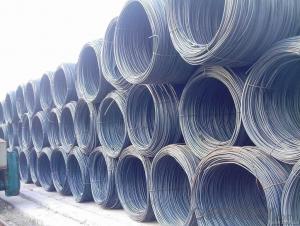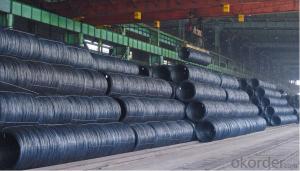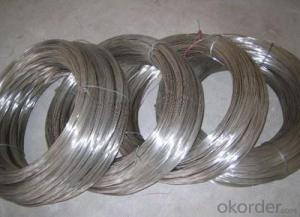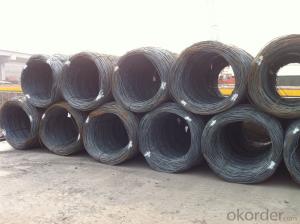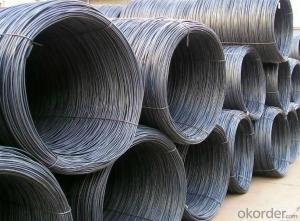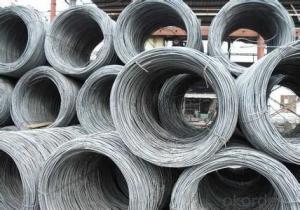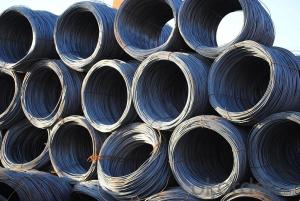Steel Wire
- Loading Port:
- China Main Port
- Payment Terms:
- TT OR LC
- Min Order Qty:
- -
- Supply Capability:
- -
OKorder Service Pledge
OKorder Financial Service
You Might Also Like
Specifications
Electro Zinc plated wire have following:Varies specification,
Stable Zinc coating and kinds packages,
Wide application
Our Electro Zinc plated wire have following advantages:
1.Specifications
The common wire diam is from BWG 6 TO BWG 38(0.18mm to 5mm).The thinner or thicker ones are also available for customers' requirements.
2.Zinc coating:5-20 g/m2 T/S:300-600N/mm2
3.Packing
Z2 spool,DIN 200 plastic reel,coils(1.5kgs/coil-1000kgs/coil),plastic or weaving bag and so on,bulk or pallet are both OK.
4.Wide applications
Mainly used in construction,fenceing mesh of Express way,making brushes,binding wire,package products etc.
Diam | BWG 6 TO BWG 36(0.2MM to 5mm),or as customers' requirement |
Zinc coating | 30-280g/m2 |
Tensile Strength | 300-600N/mm2
|
Package | Z2 spool,DIN 200 plastic reel,coils(1.5kgs/coil-1000kgs/coil),plastic or weaving bag and so on |
- Q: How is steel wire rod used in the manufacturing of wire for suspension systems in planes?
- Steel wire rod is an essential component in the manufacturing of wire for suspension systems in planes. The wire rod is typically made of high-quality steel, which offers excellent strength, durability, and flexibility. In the manufacturing process, the steel wire rod is first carefully selected and inspected for its quality. It then undergoes a series of processes, including cleaning, surface treatment, and heat treatment, to ensure its optimal properties for suspension systems. Once the steel wire rod is ready, it is further processed to form wire for suspension systems. This involves drawing the wire rod through a series of dies to reduce its diameter and increase its length. This process, known as wire drawing, helps to refine the steel wire and improve its mechanical properties. The resulting wire is then subjected to various tests, such as tensile strength and fatigue tests, to ensure its compliance with the strict safety standards required for suspension systems in planes. These tests help to verify the wire's ability to withstand the extreme forces and vibrations experienced during flight. After passing the tests, the wire is further processed to meet the specific requirements of suspension systems. It may undergo additional treatments, such as galvanizing or coating, to enhance its corrosion resistance and improve its overall performance. Finally, the manufactured wire is ready to be incorporated into the suspension systems of planes. It plays a crucial role in these systems by providing support, stability, and flexibility. The steel wire enables the suspension system to absorb the shocks and vibrations encountered during takeoff, landing, and turbulence, ensuring the safety and comfort of passengers and crew. In conclusion, steel wire rod is extensively used in the manufacturing of wire for suspension systems in planes due to its exceptional strength, durability, and flexibility. It undergoes various processes to refine its properties and is then incorporated into suspension systems, playing a vital role in ensuring safe and comfortable flights.
- Q: What are the different toughness testing methods for steel wire rod?
- There are several different toughness testing methods that can be used to assess the strength and durability of steel wire rods. Some of the commonly employed techniques are: 1. Charpy Impact Test: This method involves striking a notched specimen with a pendulum hammer and measuring the energy absorbed during fracture. It provides an indication of the material's resistance to impact loading and can be used to evaluate the ductile-to-brittle transition temperature. 2. Izod Impact Test: Similar to the Charpy test, the Izod method measures the energy absorbed by a notched specimen when struck by a swinging pendulum. This test is particularly useful for assessing the toughness of materials with low impact resistance. 3. Tensile Testing: This method involves subjecting a wire rod to a gradually increasing tensile force until it fractures. By measuring the maximum force applied and the elongation at fracture, the tensile strength and ductility of the steel can be determined. Although tensile testing does not directly measure toughness, it provides valuable information about the material's mechanical properties. 4. Bend Test: In this test, a steel wire rod is bent to a specified angle and inspected for signs of cracking or fracture. The ability of the material to withstand bending without failure is indicative of its toughness and ductility. 5. Hardness Testing: Hardness tests, such as the Rockwell or Brinell test, measure the resistance of a material to indentation. Although hardness is not a direct measure of toughness, it can provide an indication of the material's strength and ability to resist deformation. 6. Fracture Toughness Testing: This method involves measuring the critical stress intensity factor (KIC) or fracture toughness of a material. It provides information about how the material will behave under stress, including its resistance to crack propagation. Overall, these toughness testing methods help in evaluating the performance and suitability of steel wire rods for various applications, such as construction, manufacturing, and engineering. The choice of testing method depends on the specific requirements and characteristics of the material being assessed.
- Q: How does the yield strength of steel wire rod vary with different grades?
- The yield strength of steel wire rod can vary significantly with different grades. Steel wire rod is produced in various grades, each with its own unique composition and heat treatment process. The yield strength refers to the amount of stress a material can withstand before it begins to deform permanently. Different grades of steel wire rod are designed to have specific mechanical properties to meet the requirements of different applications. Generally, higher grades of steel wire rod have higher yield strengths. This is achieved by adjusting the chemical composition and heat treatment processes during manufacturing. For example, low carbon steel wire rod grades typically have lower yield strengths and are commonly used in applications where flexibility and ductility are important, such as in wire mesh and fencing. On the other hand, high carbon steel wire rod grades are known for their high yield strengths and are used in applications that require greater strength and durability, such as in automotive parts and construction materials. The yield strength of steel wire rod can also be influenced by other factors such as the size and shape of the rod, the presence of alloying elements, and the manufacturing process. It is important to consider these factors when selecting the appropriate grade of steel wire rod for a specific application to ensure optimal performance and safety.
- Q: How does the quality of steel wire rod affect the performance of wire products?
- The quality of steel wire rod plays a crucial role in determining the performance of wire products. Firstly, the strength and durability of wire products are directly influenced by the quality of the steel wire rod. High-quality steel wire rods are made from superior materials and have undergone stringent manufacturing processes, resulting in enhanced tensile strength and resistance to deformation. This ensures that wire products can withstand heavy loads, tension, and stress without breaking or losing shape. On the other hand, low-quality steel wire rods are more prone to breakage, stretching, or bending under similar conditions, leading to compromised performance and potentially hazardous situations. Secondly, the surface finish of the wire rod impacts the overall performance of wire products. A smooth and uniform surface finish, achieved through precise manufacturing techniques, reduces friction and abrasion during the use of wire products. This not only enhances their lifespan but also improves their functionality. In contrast, wire rods with poor surface finish may have rough or uneven surfaces, resulting in increased friction and wear. This can lead to premature degradation, decreased performance, and potential safety hazards. Furthermore, the chemical composition of the steel wire rod affects the corrosion resistance of wire products. High-quality wire rods are typically made from corrosion-resistant materials or have protective coatings, preventing rust or corrosion over time. This is particularly important for wire products used in outdoor or moist environments where exposure to water, humidity, or chemicals may occur. Wire products made from low-quality wire rods with inadequate corrosion resistance can deteriorate faster, leading to decreased performance, structural weakness, and potential failure. In summary, the quality of steel wire rod directly impacts the performance of wire products. Higher quality wire rods result in stronger, more durable, and longer-lasting wire products with enhanced resistance to deformation, improved surface finish, and better corrosion resistance. Investing in high-quality steel wire rods ensures the production of wire products that meet performance standards, provide reliable functionality, and ensure user safety.
- Q: Can steel wire rod be used in the production of reinforcing bars?
- Yes, steel wire rod can be used in the production of reinforcing bars. Reinforcing bars, also known as rebar, are used to strengthen and reinforce concrete structures such as buildings, bridges, and highways. Steel wire rod is a raw material that can be used in the manufacturing process to produce rebar. The wire rod is typically made from high-quality steel and is drawn into the desired thickness and shape to meet the specific requirements for reinforcing bars. It provides the necessary strength and durability to enhance the structural integrity of concrete and prevent cracking or failure. Therefore, steel wire rod is a fundamental component in the production of reinforcing bars.
- Q: How is steel wire rod used in the production of wire harnesses?
- Steel wire rod is an essential component in the production of wire harnesses. Wire harnesses are used in various industries, including automotive, aerospace, and electronics, to connect and organize electrical wires and cables. Steel wire rods serve as the base material for manufacturing the wires used in wire harnesses. These rods are typically made from carbon steel and go through a series of processes to transform them into wires of various thicknesses and diameters. The wire rods are first cleaned and coated with a lubricant to enhance their durability and flexibility. Once the wire rods are prepared, they are drawn through a series of dies to reduce their diameter and increase their length. This drawing process helps in aligning the steel molecules, making the wires stronger and more uniform. The drawn wires are then annealed to relieve internal stresses and further enhance their ductility. The resulting steel wires, which are now smooth and uniform, are then used in the production of wire harnesses. These wires are cut to the required lengths and stripped at specific points to expose the conductive metal. The stripped ends are then soldered or crimped to connectors, terminals, or other electrical components. The wires are then bundled together using various techniques, such as braiding, taping, or plastic molding, to form the final wire harness. Steel wire rods play a crucial role in the production of wire harnesses as they provide the necessary strength and conductivity required for efficient electrical connections. The quality and properties of the steel wire rod directly impact the performance and reliability of the wire harnesses, making it essential to use high-quality materials in their production.
- Q: What are the different types of steel wire rod rolling mills?
- There are several types of steel wire rod rolling mills, including continuous mills, semi-continuous mills, and reversing mills. Continuous mills are designed for high-speed production and feature a constant flow of material through the mill. Semi-continuous mills allow for a slower production rate and are ideal for smaller-scale operations. Reversing mills have the ability to roll the material in both directions, providing flexibility for different product specifications.
- Q: What are the different surface finishes available for steel wire rods?
- There are several surface finishes available for steel wire rods, including hot-dip galvanized, electro-galvanized, phosphatized, and uncoated. Each finish offers unique properties and benefits depending on the intended application and environmental conditions.
- Q: What are the main factors influencing the choice of steel wire rod warranty?
- The main factors influencing the choice of steel wire rod warranty are the quality of the steel wire rod, the reputation of the manufacturer, and the terms and conditions of the warranty itself. Firstly, the quality of the steel wire rod plays a significant role in the choice of warranty. Buyers would prefer a higher quality product that is less likely to have defects or issues, thus reducing the need for warranty claims. The overall strength, durability, and performance of the steel wire rod are crucial factors in determining the level of confidence in the product and, subsequently, the warranty. Secondly, the reputation of the manufacturer also influences the choice of warranty. A manufacturer with a proven track record of producing high-quality steel wire rods and providing reliable warranties is more likely to instill trust in the buyer. Positive reviews, testimonials, and references from other customers can contribute to the decision-making process, as they provide insights into the manufacturer's commitment to customer satisfaction and after-sales service. Lastly, the terms and conditions of the warranty itself are an essential factor. Buyers consider factors such as the duration of the warranty, the coverage it provides, and any limitations or exclusions mentioned in the warranty documentation. A longer warranty period and comprehensive coverage, including protection against manufacturing defects or premature failure, are often preferred. Additionally, factors like the process for filing warranty claims, the responsiveness of the manufacturer's customer service, and the ease of warranty fulfillment are also taken into account. In summary, the main factors influencing the choice of steel wire rod warranty include the quality of the product, the reputation of the manufacturer, and the terms and conditions of the warranty. Buyers prioritize a high-quality product, a reputable manufacturer, and a warranty with favorable terms and comprehensive coverage.
- Q: How is steel wire rod used in the production of tire cords?
- Tire cords rely on steel wire rod, an indispensable element, for their production. These cords are embedded within the rubber of tires to offer strength and support. The steel wire rod undergoes a sequence of steps to achieve the desired form for tire cord manufacturing. To begin with, the steel wire rod undergoes hot rolling, which reduces its diameter and increases its length. This process enhances the wire rod's strength and flexibility, making it suitable for tire cord applications. Following hot rolling, the wire rod is subjected to a heat treatment known as patenting. This treatment improves the wire's mechanical properties, such as tensile strength and elasticity, ensuring it can endure the demanding conditions tires face. Once appropriately processed, the steel wire rod is drawn through a series of dies to attain the desired diameter and surface finish. This drawing process further enhances the wire's strength and surface quality, meeting the strict requirements for tire cord production. Next, the drawn steel wire rod is coated with a layer of brass or zinc to enhance its adhesion to the rubber compound used in tire manufacturing. This coating also provides corrosion resistance, extending the lifespan of the tire cords. Lastly, the coated steel wire rod is twisted into cord structures with multiple strands, forming the tire cord. These cords are then embedded into the rubber during the tire manufacturing process. They play a vital role in reinforcing the tire, enabling it to withstand internal pressure, external forces, and maintain stability during vehicle movement. In conclusion, steel wire rod is an essential material in the production of tire cords. Through a series of processing steps, including hot rolling, heat treatment, drawing, and coating, the wire rod is transformed into durable and high-strength cords. These cords are embedded within the rubber of tires to provide crucial reinforcement and support, ensuring the tires can endure the challenging road conditions they encounter.
Send your message to us
Steel Wire
- Loading Port:
- China Main Port
- Payment Terms:
- TT OR LC
- Min Order Qty:
- -
- Supply Capability:
- -
OKorder Service Pledge
OKorder Financial Service
Similar products
Hot products
Hot Searches
Related keywords
